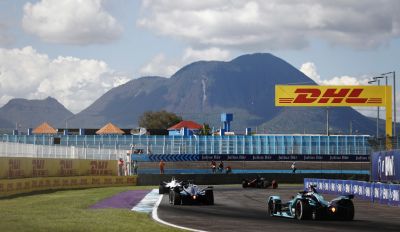Air, Feature, Freight News, Logistics
Logisticians search for a carbon-free formula
[ July 22, 2024 // Chris Lewis ]Getting an electric race car to move at up to 200mph is the easy bit. What can be far tougher is squeezing the last grams of CO2 emissions out of the supply chain that brings the Formula E championship to 132 races, 33 cities and 24 countries.
DHL has been delivering logistics support to Formula E since its inception in 2014, an anniversary marked by the DHL presentation of a Gen 1 car adorned in a custom livery on the eve of the final stage of the event, which took place at London’s Excel Arena on 20-21 July.
Formula E is increasing in popularity and it as keenly contested as its ‘petrolhead’ equivalent. For a generation for whom the epitome of electric vehicle technology was a 10mph milk float, the sight of cars hurtling almost noiselessly around a track at up 20 times that speed is quite surreal.
As Barry Mortimer, paddock and logistics director for Formula E explains, while its logistics requirements are modest compared with the 30 freighter aircraft that the petrol-powered Formula 1 uses, there is a great deal of pressure on its greener younger brother to reduce its carbon footprint in every way possible. In fact, Formula E will shortly reduce its requirements from three chartered 747F aircraft to only two.
Wherever possible, it uses seafreight or land transport instead of air. Logistics partner DHL has developed special wheeled boxes that can be used in aircraft, shipping containers, trucks and trains.
Formula E uses HVO fuel for almost all its trucks – all of them to the latest Euro 6 emissions standard – and, where material does have to be flown, it uses sustainable aviation fuel (SAF) whenever it can. For the second time in this year’s Championship, the freight will be transported using DHL’s GoGreen Plus service, using SAF for nearly 5,000 miles from Portland to London cutting greenhouse gases by 80% compared to conventional jet fuel.
The race organizers are also minimizing the amount of kit that needs to be moved around, for example by having duplicates of bulky items like safety cars strategically positioned in various parts of the world. Formula E teams are set stringent limits on the amount of kit they are allowed to move.
What has also helped is that the technology of the racing cars has improved. When Formula E was launched, every driver had two cars for each event; now it is only one thanks to the improvement in battery technology that has allowed a single car to complete the event without recharging.
However, as in any motor sport, the schedule is relentless and, as Mortimer says: “We need to put on a show.”
The time pressure, with as little as 3-4 days to dismantle everything, pack it up, move it hundreds of miles to the next venue and reassemble it, means that up to now, Formula E hasn’t been able to use electric heavy goods vehicles. The schedules don’t have any leeway in which an electric truck could be recharged en route. However, that might change as electric HGV capabilities improve.
Lithium batteries, as might be expected, are the most difficult components of Formula E to transport, especially by air, Mortimer continues. “We have special procedures signed with the various civil aviation authorities around the world,” he explains. These have to be agreed months in advance and, because every authority does things slightly differently, different agreements apply for each air leg.
There are different rules for batteries that are installed in cars from out-of-car batteries – the latter are in fact more onerous and need special certification, says Mortimer. Also, the rules are tighter for Lithium batteries weighing over 35kg where, “you are in a whole world of pain”.
There are also rules governing the state of charge under which batteries can be airfreighted.
Formula E’s logistics managers are in pretty much constant contact with IATA and the aviation authorities. “It would be really great if there was someone from the automotive industry embedded there. If they see the stringent testing that batteries go through, it would help write better regulations.”
In fact, in ten years of Formula E, Mortimer can only recall one fire incident in a battery and that occurred at a venue, not in transportation. Lessons have been learned and the fault that led to the fire has been fixed.

Tags: DHL











